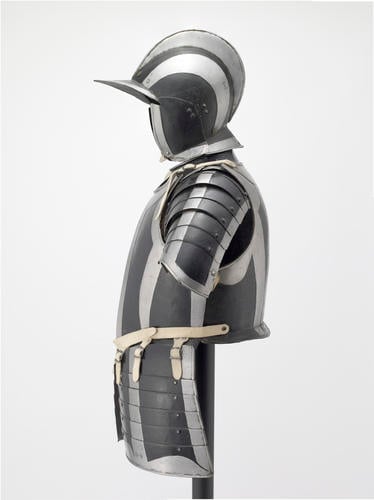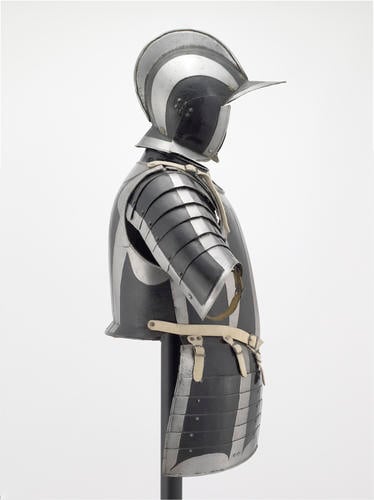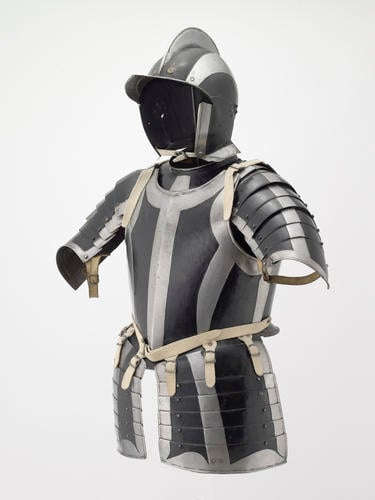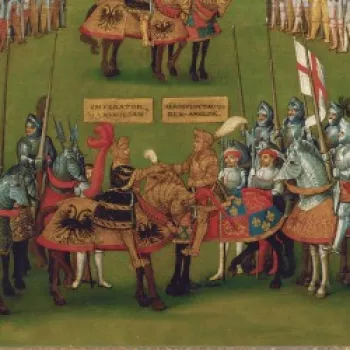Composite 'Almain' corselet about 1600-10
Low carbon steel, copper alloy, leather, paint. | RCIN 67356






-
Composite corselet consisting of a burgonet with associated cheek-pieces, a collar later converted to ‘Almain’ form by the fitting of its outer ends with spaudlers, a breastplate of late 'peascod' fashion with fauld, two pendent tassets not forming a pair and a backplate.
The main edges of the armour are formed with plain, inward turns. Its surfaces are decorated throughout with raised bands and borders polished bright against a blackened ground in the so-called ‘black and white’ fashion. The blacking has been extensively refreshed.
Contemporaries distinguished 'Almain' corselets from 'Flanders' corselets by their chequered (that is, parti-coloured) decoration and their lack of vambraces. However, the collar of an 'Almain' corselet would have been equipped with ‘bombardes’ or integral spaudlers to protect the shoulders.
Tests undertaken on the turned edge of the right arm-opening of the breastplate show its microhardness to vary in the range 215–253 VPH (average 231 VPH). It is formed of a heterogeneous low carbon steel with numerous irregular slag-inclusions. Mixed in with the steel are some bands of pure iron. The carbon content of the steel reaches about 0.2–0.3% in places. The helmet was probably made from a ‘bloom’ of low carbon steel that was folded and forged into a plate.
Text adapted from Norman, A.V.B, & Eaves, I. 2016. Arms and Armour in the Collection of Her Majesty The Queen: European Armour, London.
Metallurgy by Williams, A, & Metcalf, S. 2016. Summary of the metallurgy of European Armour in the Royal Collection. London. Appendix II of Norman & Eaves
Measurements: Helmet: height 29.8 cm, width 22.2 cm, depth 34.3 cm; Gorget: height of main plates 17.8 cm, width of main plates 29.2 cm, width of main plates with associated spaudlers 81.9 cm, internal diameter of neck-opening 13.7 cm; Breastplate: height from shoulders to lower edge of waist-flange 35.6 cm, width beneath arm-opening 36.3 cm, width at waist 30.5 cm; Right Tasset: height 26.7 cm, width 27.3 cm; Left Tasset: height 26.1 cm, width 27.0 cm; Backplate: height from shoulders to lower edge of waist-flange 38.3 cm, width beneath arm-openings 35.6 cm, width at waist 29.8 cm.
Weights: Helmet: 1.177 kg; Gorget with associated Spaudlers: 2.013 kg; Breastplate: 2.126 kg; Right Tasset: 0.723 kg; Left Tasset: 0.765; Backplate: 1.970 kg.
Provenance
This armour was one of five catalogued in the Tower Armouries in 1859 as 'Suits of black and white raised armour, of the first half of the 17th century'. They could well have formed part of the indigenous collections of the Tower, since in the late sixteenth and early seventeenth centuries armours of this kind were stored there in large numbers. On 4 August 1588, for example, the Privy Council had sought better to equip troops raised to meet the threat of a Spanish invasion by authorising the sale ‘out of her Majesties Store in the Armorie in the Tower’ of about 800 ‘Almaine corsletes complete’. The use of such armour clearly continued into the following century. The Armouries accounts for 2 October 1625 to 30 September 1626 record that £113 10s was paid to the London armourers William Coxe, Edward Annesley and William Hayward for ‘making serviceable’ some ‘227 almain corslets’.
This armour is documented at Windsor Castle by 1904 as 'a half suit of German early 17th century armour...decorated with sunken panels painted black' and 'obtained from the Tower of London'. -
Creator(s)
(nationality) -
Medium and techniques
Low carbon steel, copper alloy, leather, paint.
Category
Object type(s)
Bibliographic reference(s)
Laking AA : Laking, G.F., 1904. The Armoury of Windsor Castle, London page 243
Place of Production
Germany








